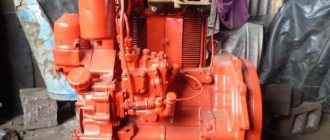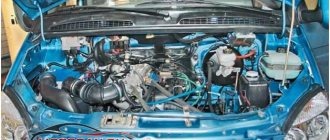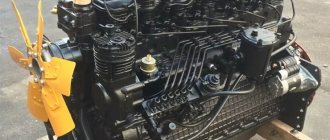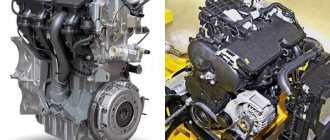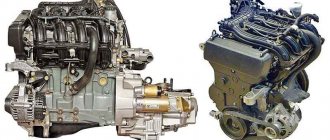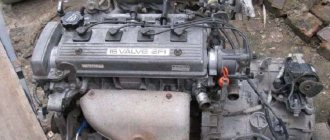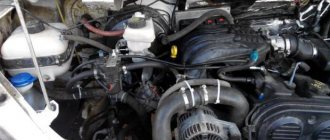Engine GAZ-53
Two main models of power units were installed on GAZ-53 cars: the six-cylinder GAZ-11 and the eight-cylinder ZMZ-53. The second motor had several different modifications, but there was no significant difference in their design.
Despite the high build quality and reliability, the GAZ-53 engine requires repair work over time.
Cabin
The cabin was removed using a tractor on our own, but to remove the body we had to call a fiskar. They dismantled their original engine, and all that remained was a bare frame with wheels.
The front beam was removed, the gas 53 rear axle too, the frame was cleaned with a grinder, there weren’t even any shock absorber mounts left. The frame was left completely bare; we dragged it closer to the gate, since the other day we were supposed to bring a well-preserved frame from the bus.
Return to contents
Motor maintenance
Internal combustion engines belonging to the ZMZ-53 family are distinguished by a good service life and reliability, however, like any other power units, they require regular maintenance. Such preventive measures include:
- Change the lubricant. The oil used in the GAZ-53 engine is either mineral or synthetic or semi-synthetic. It has to be changed every 5-6 thousand kilometers for the first type, for the second - every 10-12 thousand. However, synthetic oils are not entirely suitable for such an engine, and it is not advisable to use them.
- Regular tightening of intake manifold mounts and cylinder heads. In other situations, the tightening is checked every 30 thousand kilometers, but it can be done more often. The weak point of the engine is precisely the intake manifold, which often runs as a “screw”. Its nuts are tightened very simply and are freely accessible.
- Checking the coolant level. It is advisable to carry it out before each trip by car. Repair of the GAZ-53 engine is often a consequence of insufficient fluid level in the cooling system.
- Checking valves. Their adjustment is carried out only after changing the cylinder head gaskets or if the GAZ-53 engine has undergone major repairs. In other cases, adjustments to their work occur only if they start knocking. The valves themselves, as a rule, do not fail, so in most cases they are pressed too hard by the craftsmen during work. As practice shows, it is better if they knock a little.
- Checking the oil level. The procedure is carried out daily. If there is a shortage of oil, add it to the required level.
- Repairing the GAZ-53 engine may involve sealing oil leaks. In most cases, lubricant flows through the rear main bearing, so its inspection is carried out only in the inspection hole.
In order for the GAZ-53 engine to work as much as possible without malfunctions, it is necessary to regularly diagnose it, correct problems in a timely manner and fill only with high-quality engine oil.
Beam, rear and front axle
When I was on a business trip, my son disassembled the front beam himself, after that, having bought new kingpins, we began to assemble the car. We replaced the support washers with support bearings. Having replaced the kingpins, we also changed the brake cylinders; the old ones did not work at all. Having assembled the front beam, we moved on to the springs.
The springs had 13 leaves on each side. I removed 1 leaf and cut 2 new rear main springs to size and added them to each side. This was done because the D-243 is 130 kg heavier than the original engine.
Rear springs (13 on each side) were added for load capacity - 3 leaves on each side. It turned out to be 16 sheets, one for each spring.
I’ll find out if the load capacity has changed after the first loaded test drive. I wanted to install shock absorbers to absorb impacts, but I couldn’t install them because the stepladders were not long enough.
After the beam and rear axle were installed and all the frame work was completed, this is what the lawn looked like.
Then we moved to the front and started fiddling with the engine mounts. I am attaching a photo of the whole process.
Here we estimated the dimensions, mounting holes, and simply took it and temporarily placed it on the frame with the help of a tractor.
GAZ-53 engine: technical characteristics
Vehicles of this brand are equipped with several modifications of power units. Since 1966, the GAZ-53 engine was installed on GAZ cars. The model was equipped with a K-126B carburetor and had an overhead valve arrangement. A little later, the characteristics of the GAZ-53 engine changed, since the carburetor was replaced with a K-135.
This engine has a small piston stroke and cylinder volume. Many are of the opinion that parts of other internal combustion engines from the same line can be installed on the GAZ-53 engine. The technical characteristics of these motors are somewhat different, so their elements are not interchangeable. Not only the cylinder blocks are different, but also the cylinder head, piston group and crankshaft.
Installing the motor on other cars
Any car, especially a Soviet one, has been tuned at least once. Thus, the 53rd is third after the Volgovsky (GAZ 24) and Uazovsky (UMZ-417) power units in terms of popularity in modification, since it has a simple design and is easy to introduce innovations. But, nevertheless, it gained great popularity due to the introduction of the engine into other cars. So repeatedly, you can find a UAZ with a GAZ 53 engine.
For those who love the forced GAZ 24 or 3102, they can easily install the ZMZ 511. You can often see a Volga racing with a GAZ 53 engine. But there are a number of disadvantages: puffs of smoke from the exhaust, uncharacteristic engine sound, broken driveshaft, and more. .
Thus, the installation of ZMZ 511 on a GAZ 24 should be approached seriously and all the nuances fully calculated, since the internal potential is quite large, but not everyone has the intelligence to complete it.
Engine diagnostics
Regular inspection is necessary for the cylinder block. If its fastenings become loose, tighten the nuts. Before carrying out such work, all the coolant is drained from the system and the fastening of the intake pipe is loosened - this makes it possible to prevent the tightening of one cylinder head from affecting the others.
After such procedures, the nuts are tightened with a torque wrench. The manufacturer recommends performing this type of work for the first three maintenance services, then its frequency can be reduced to every second.
The GAZ-53 engine does not require repairs provided that high quality lubricants and fuel are used. In this case, the carbon deposits formed on the pistons and inside the combustion chamber will be small and will not have any effect on the operation of the engine.
Failure to follow simple rules can lead to detonation, increased consumption and decreased power.
Fuel system
Here is a photo after some configuration of the already connected fuel system.
Now I’ll tell you about the fuel system.
It remains the same, the Zilov tank is 125 liters. moved to the driver's side, and so did the sump.
All the work was done with my own hands without the help of outside specialists.
Source
Replacing piston rings
The main sign that it is time to change the piston rings is an increase in lubricant consumption. Normally it is 400 g per 100 kilometers. The piston ring set includes steel discs and a cast iron compression ring.
During replacement, the unworn section of the belt is removed from the cylinder liners, and the cylinder head is cleaned of carbon deposits.
The gas distribution mechanism also requires regular diagnostics. Valve clearances are checked only with the engine idling and the pusher lowered all the way.
Possible malfunctions of the GAZ-53 internal combustion engine
The power unit has breakdowns and malfunctions that are typical for any other engine. To eliminate them, the GAZ-53 engine is completely disassembled and reassembled. The reasons for breakdowns can be different:
- The appearance of knocking of brass liners. This is the most serious malfunction. It is caused by low oil level, wear of all parts, or reduced or completely absent pressure in the system.
- Increased lubricant consumption. Oil can either flow through the seals and connections, or through the piston rings. This could also be caused by a clogged breather.
- Knocking of connecting rod bushings or pistons. Pistons are characterized by burnout of the bottom or failure of the partitions between the rings. The main reason for this is engine overheating.
- Burnout of exhaust valves. They do not burn out by themselves, but you can often encounter wear on the guide bushings. There may be several reasons for this: ingress of engine oil, low quality fuel, or lack of clearance in the valves.
- Burnout of cylinder block gaskets. The reason is overheating of the engine, which can lead to curvature of the surface of the heads.
Price of a new and contract engine
The engine for the Gas 53 car is no longer produced. But there are old engines in use, as well as parts on them that keep the power unit running. Old tuned engines cost from twenty thousand rubles. All the parts that power the engine are updated.
Such motors are sold for 50 and 60 thousand rubles. More rare ones, for example, such as the 511 model, are sold for 208 thousand rubles.
Engine overhaul
With proper care, the GAZ-53 engine rarely needs major repairs, but if this does happen, the following malfunctions may be the cause:
- Increased lubricant consumption, and with the replacement of rings the problem remained relevant.
- Low pressure in the lubrication system and knocking noises in the engine.
- Wear of the entire power unit with exhaustion of its working life.
- Engine jamming due to the crankshaft.
Engine repairs can be carried out independently - the manufacturer issues a complete operating manual, in which all steps for changing parts and possible malfunctions and methods for eliminating them are described in detail.
Despite everything, the engines installed on the GAZ-53 are distinguished by good endurance. Considering the various “modifications” of the internal combustion engine and the oils that are sometimes poured into it, one can only be surprised at its performance. Often such an engine can function quietly for years, even if there are strange knocking noises.
Conversion of ZIL, GAZ, PAZ from gasoline to diesel D-245 installation on ZIL-130, Gaz-53
Conversion of ZIL, GAZ, PAZ from gasoline to diesel D-245 installation on ZIL-130, Gaz-53
Conversion of ZIL-130 from gasoline to diesel D-245 (D245) to ZIL-130
About the benefits and advantages of converting a car engine to diesel
It offers enterprises and organizations that actively use trucks in their activities a rational and effective way to improve the technical characteristics of trucks and reduce fuel costs.
Converting a vehicle to diesel can significantly reduce the cost of operating a truck due to the better fuel efficiency of diesel compared to gasoline engines. Replacing the standard internal combustion engine with a diesel engine reduces fuel consumption by half - from 38 liters of gasoline to 18 liters of diesel fuel per 100 km. Practical experience shows that the cost of installing a diesel engine pays off on average in one year, and subsequently operating a ZIL-130 or GAZ-53 with a diesel engine allows you to save about 200,000 rubles annually.
The company carries out conversion work on ZIL and GAZ vehicles at its own production base in Saratov. The engines are installed in the factory configuration and with all the necessary attachments. The work is completed in the shortest possible time to save time and money for our clients. The installed motors are provided with a manufacturer's warranty.
We offer you a service for converting ZIL, GAZ, PAZ cars and their modifications with a ZIL-508.10 engine to a D-245turbo engine. The average payback period is 1 year. The benefits of the conversion are obvious. The conversion includes: engine d - 245.12C. with turbocharging, a kit for engine conversion, work on replacing a gasoline engine with a diesel one, the entire package of documents for registration. Economic feasibility lies in a sharp reduction in fuel consumption. According to our calculations, with a daily vehicle mileage of about 100 km, the cost of re-equipment will be recouped within about a year.



